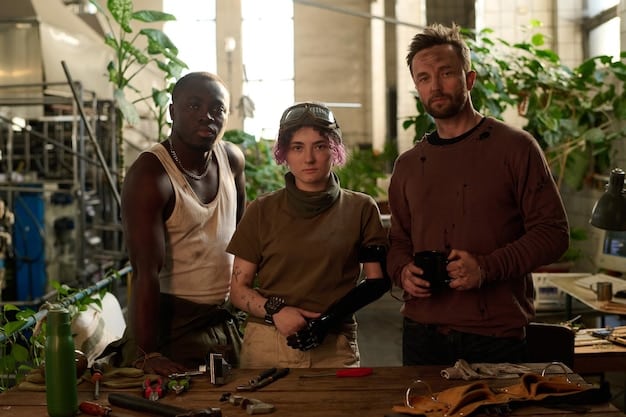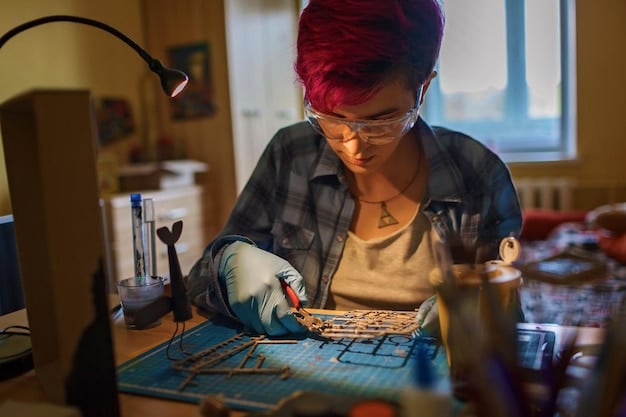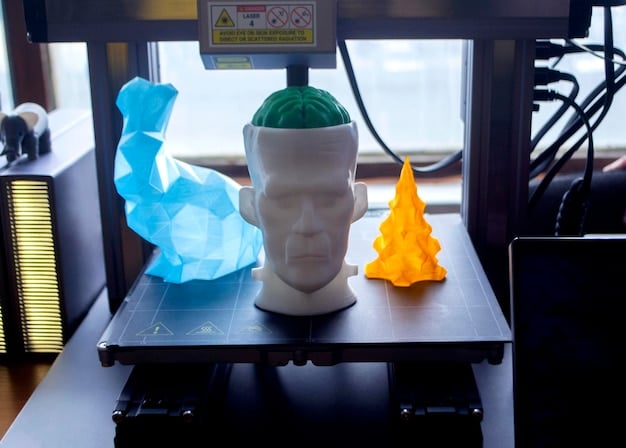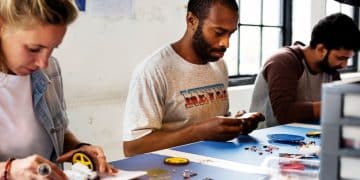Maker Culture: DIY Innovation Shaping US Subcultures & Industries

Maker culture, a contemporary subculture in the US, champions Do-It-Yourself (DIY) principles, fostering innovation and creativity across various industries through community collaboration, shared knowledge, and accessible technology, transforming how products are designed, created, and consumed.
The maker culture and the future of innovation are intertwined, particularly within the vibrant subcultures and evolving industries of the United States. This movement, rooted in the Do-It-Yourself (DIY) ethos, is reshaping how we approach technology, creativity, and community engagement.
Understanding the Core of Maker Culture
At its heart, maker culture is about empowering individuals to create, modify, and invent. It’s a rejection of passive consumption and an embrace of hands-on innovation. This movement thrives on collaboration, shared knowledge, and the accessibility of tools and technologies.
Maker culture is more than just a hobby; it’s a mindset. It encourages experimentation, learning through doing, and the belief that anyone can be a creator. Let’s delve deeper into the key aspects that define this dynamic phenomenon:
The DIY Ethos
The DIY (Do-It-Yourself) spirit is the cornerstone of maker culture. This involves a hands-on approach to problem-solving and creation, often utilizing readily available materials and resources.
Open Source Principles
Many makers embrace open-source principles, sharing their designs, code, and knowledge freely. This collaborative approach fosters innovation and allows others to build upon existing creations.
Community and Collaboration
Maker culture thrives on community. Makerspaces, online forums, and events provide spaces for individuals to connect, share ideas, and collaborate on projects.
These aspects combine to create a powerful force for innovation and creativity. The next section explores how maker culture is influencing various subcultures within the US.
Maker Culture’s Influence on US Subcultures
Maker culture has permeated various subcultures across the US, each bringing its unique perspective and application to the DIY ethos. From technology enthusiasts to artists and crafters, the maker mindset is fostering new forms of creativity and community engagement.
Let’s examine how maker culture is shaping specific subcultures:
The Tech Enthusiast Community
For tech enthusiasts, maker culture provides an outlet for experimentation and innovation. They often focus on building and modifying electronics, robotics, and other technological creations.
The Arts and Crafts Movement
Artists and crafters are embracing maker culture to create unique and personalized works. This includes everything from handcrafted jewelry to textile art and upcycled furniture.
The Hacker Culture
The hacker culture, with its emphasis on problem-solving and unconventional approaches, aligns perfectly with maker culture. Hackers often use their skills to modify and repurpose existing technologies.

These subcultures are not isolated; they often intersect and collaborate, creating a vibrant and diverse maker ecosystem. The following points highlight some specific examples of how maker culture is manifesting in subcultures:
- Cosplay: Makers are creating intricate costumes and props using 3D printing, electronics, and traditional crafting techniques.
- Homebrewing: DIY enthusiasts are brewing their own beer and experimenting with different flavors and techniques.
- Urban Farming: Makers are building their own hydroponic systems and vertical gardens to grow food in urban environments.
Maker culture is breathing new life into these subcultures, fostering creativity, innovation, and a sense of community. The next section explores the tangible impacts of this movement on various industries.
The Impact of Maker Culture on Industries
The maker culture and the future of innovation are reshaping industries across the US, influencing product development, manufacturing processes, and even business models. Its open-source principles has led to transformative change in several sectors.
Let’s examine how the DIY ethos is impacting industries:
Manufacturing and Prototyping
Makerspaces and fab labs are providing individuals and small businesses with access to advanced manufacturing tools, enabling rapid prototyping and small-scale production.
Education and STEM Learning
Maker culture is being integrated into education to promote hands-on learning, problem-solving skills, and creativity in STEM (Science, Technology, Engineering, and Mathematics) fields.
Entrepreneurship and Innovation
The maker movement fosters entrepreneurial spirit by empowering individuals to develop and commercialize their own products and ideas.
Consider these specific examples of maker culture’s influence on industries:
- 3D Printing: The accessibility of 3D printing is revolutionizing manufacturing, allowing for customized products and on-demand production.
- Open-Source Hardware: Platforms like Arduino and Raspberry Pi are empowering makers to create innovative electronic devices and applications.
- Crowdfunding: Platforms like Kickstarter and Indiegogo are enabling makers to fund their projects and bring their ideas to market.

The Role of Open-Source Principles
The adoption of open-source principles has been transformative, allowing for the sharing of designs and methodologies. This collaborative environment accelerates innovation and reduces barriers to entry. Companies are also finding that by embracing open-source methods, they can tap into a wider pool of talent and expertise, leading to more rapid and diverse innovations.
The convergence of these elements highlights the significant contribution of maker culture to economic growth and technological advancement. In the next section, we will discuss the technologies that are further accelerating the growth of the maker movement.
Key Technologies Fueling the Maker Movement
Several key technologies are fueling the maker movement, making it easier and more accessible than ever before for individuals to create and innovate. These tools provide makers with the resources to materialize their ideas, fostering a culture of experimentation and learning.
Let’s look at some of the most influential technologies:
3D Printing and Additive Manufacturing
3D printing has revolutionized prototyping and manufacturing, allowing makers to create complex objects from digital designs. This technology removes the constraints of traditional manufacturing methods, enabling highly customized and intricate designs.
Microcontrollers and Embedded Systems
Platforms like Arduino and Raspberry Pi have made electronics programming accessible to a wider audience, enabling makers to build interactive devices and applications. These devices are inexpensive and offer intuitive coding interfaces, making them ideal for beginners.
Laser Cutting and CNC Machining
Laser cutters and CNC machines allow makers to precisely cut and shape materials, enabling the creation of intricate designs and functional prototypes. These tools increase precision and repeatability, making them vital for detailed and accurate fabrication.
Software and Design Tools
User-friendly software and design tools are empowering makers to create digital designs and simulations, further streamlining the creation process.
Each of these technologies plays a crucial role in breaking down barriers to entry and empowering makers to bring their ideas to life. To highlight the role of software and design tools, here are examples:
- CAD Software: Programs like TinkerCAD and Fusion 360 provide makers with tools to create and modify 3D models.
- Simulation Software: Tools that allow makers to simulate and test their designs before physical creation, reducing waste and time.
- PCB Design Software: Programs for designing custom printed circuit boards, essential for creating electronic devices.
Together, these technologies are creating a powerful ecosystem that is driving innovation and creativity within the maker movement. The economic implications of this movement are substantial, which will be discussed in the following section.
Economic Implications of Maker Culture
The economic implications of maker culture are significant, contributing to job creation, innovation, and local economic development across the US. Its grassroots approach to problem-solving and production is reshaping the economic landscape.
Here are some key economic impacts:
Job Creation and Entrepreneurship
The maker movement encourages entrepreneurship by providing individuals with the tools and resources to start their own businesses and create new products. This has led to the emergence of numerous small businesses founded on innovative, maker-driven ideas.
Local Economic Development
Makerspaces and fab labs serve as hubs for innovation and economic activity, attracting talent, fostering collaboration, and supporting local businesses. This contributes to the revitalization of local economies by promoting a culture of innovation and self-reliance.
Increased Competition and Innovation
Maker culture fosters competition by lowering barriers to entry and enabling new businesses to emerge, leading to increased innovation and better products. This competitive environment drives companies to be more responsive to customer needs and to invest in research and development.
Consider these specific examples of the economic impact of maker culture:
- The Rise of Etsy: Home to numerous independent creators and small businesses that sell handmade and unique products.
- Local Makerspaces: These establishments provide tools, training, and community support to local makers, promoting economic activity within the region.
- Crowdfunding Successes: Many innovative products and startups have successfully launched through crowdfunding platforms.
The Potential for Reshoring
As maker culture becomes more widespread, there is potential for some manufacturing to return to the US, contributing to job growth and economic resilience. This reshoring trend could revitalize industrial regions and create new opportunities for skilled workers.
The economic implications of maker culture extend beyond the immediate impact of job creation and local development. In the closing section of this analysis, we will delve into the future trends influencing this dynamic movement.
Future Trends in Maker Culture
The future of maker culture holds exciting possibilities as new technologies emerge and the movement continues to evolve. Several key trends are shaping the direction of DIY innovation, indicating where the most significant progress will be made.
Here are some trends to watch:
Increased Focus on Sustainability
Makers are increasingly focused on sustainable practices, using recycled materials, designing for durability, and promoting circular economy principles. As environmental awareness grows, the maker movement will likely see an increase in projects aimed at reducing waste and promoting ecological responsibility.
Integration of AI and Machine Learning
AI and machine learning are being integrated into maker projects, enabling new forms of automation, personalization, and creativity. These integrations will expand the possibilities for maker creations, allowing for more complex and intelligent systems.
Expansion of Virtual and Augmented Reality Applications
VR and AR technologies are being used to design, simulate, and collaborate on maker projects, offering new ways to visualize and interact with creations. The combination of maker skills with VR/AR tools promises the creation of immersive and interactive experiences.
Looking further into some of these trends allows one to visualize their impact:
- Personalized Medicine: Makers could create customized medical devices and assistive technologies using 3D printing and bioengineering techniques.
- Smart Homes: DIY enthusiasts may develop advanced home automation systems that optimize energy usage and improve comfort.
- Educational Tools: Makers might contribute to the creation of interactive learning tools that engage students and promote STEM skills.
| Key Point | Brief Description |
|---|---|
| 💡 DIY Ethos | Hands-on creation using available resources. |
| 🤝 Community & Collaboration | Sharing ideas in makerspaces & online forums. |
| 🚀 Tech & Innovation | New products, manufacturing, STEM education. |
| 🌱 Sustainability | Focus on recycling, durability, and eco-friendly designs. |
Frequently Asked Questions
▼
Maker culture is a contemporary subculture centered on DIY principles. It emphasizes hands-on creation, modification, and innovation across various fields, like technology, arts, and engineering.
▼
Maker culture is democratizing manufacturing through access to tools like 3D printers and CNC machines. This enables rapid prototyping, customized production, and small-scale manufacturing.
▼
Makerspaces are community workshops providing access to tools, resources, and expertise. They function as collaborative hubs, fostering innovation and enabling individuals to realize their creative projects.
▼
Open-source principles are foundational. They encourage sharing designs, code, and knowledge, fostering collaboration and accelerating innovation by allowing makers to build on each other’s work.
▼
Maker culture is being integrated into education to boost STEM learning. Emphasizing hands-on projects aims at fostering creative problem-solving as well as critical thinking skills among students.
Conclusion
In conclusion, the maker culture represents a significant shift towards democratized innovation, impacting various industries and subcultures within the US. Fueled by accessible technologies, collaborative communities, and a DIY ethos, this movement is poised to continue shaping the future of creativity, entrepreneurship, and economic development.





